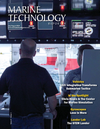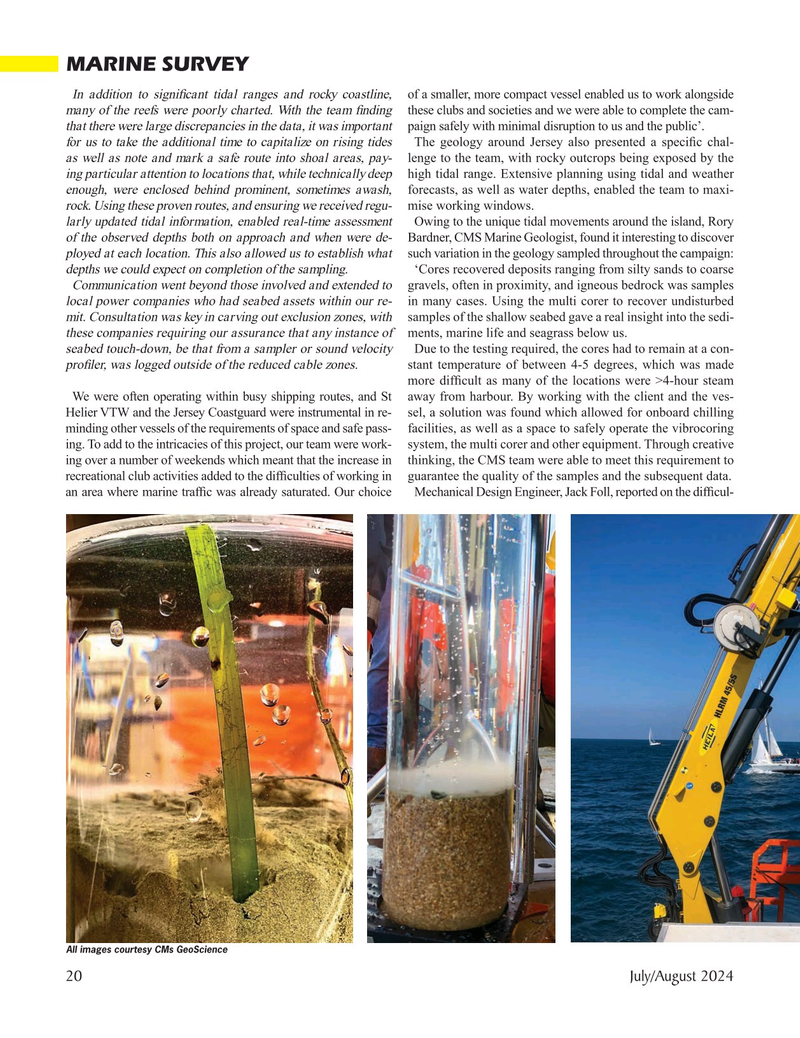
Page 20: of Marine Technology Magazine (July 2024)
Read this page in Pdf, Flash or Html5 edition of July 2024 Marine Technology Magazine
MARINE SURVEY
In addition to signi? cant tidal ranges and rocky coastline, of a smaller, more compact vessel enabled us to work alongside many of the reefs were poorly charted. With the team ? nding these clubs and societies and we were able to complete the cam- that there were large discrepancies in the data, it was important paign safely with minimal disruption to us and the public’.
for us to take the additional time to capitalize on rising tides The geology around Jersey also presented a speci? c chal- as well as note and mark a safe route into shoal areas, pay- lenge to the team, with rocky outcrops being exposed by the ing particular attention to locations that, while technically deep high tidal range. Extensive planning using tidal and weather enough, were enclosed behind prominent, sometimes awash, forecasts, as well as water depths, enabled the team to maxi- rock. Using these proven routes, and ensuring we received regu- mise working windows.
larly updated tidal information, enabled real-time assessment Owing to the unique tidal movements around the island, Rory of the observed depths both on approach and when were de- Bardner, CMS Marine Geologist, found it interesting to discover ployed at each location. This also allowed us to establish what such variation in the geology sampled throughout the campaign: depths we could expect on completion of the sampling. ‘Cores recovered deposits ranging from silty sands to coarse
Communication went beyond those involved and extended to gravels, often in proximity, and igneous bedrock was samples local power companies who had seabed assets within our re- in many cases. Using the multi corer to recover undisturbed mit. Consultation was key in carving out exclusion zones, with samples of the shallow seabed gave a real insight into the sedi- these companies requiring our assurance that any instance of ments, marine life and seagrass below us.
seabed touch-down, be that from a sampler or sound velocity Due to the testing required, the cores had to remain at a con- pro? ler, was logged outside of the reduced cable zones. stant temperature of between 4-5 degrees, which was made more dif? cult as many of the locations were >4-hour steam
We were often operating within busy shipping routes, and St away from harbour. By working with the client and the ves-
Helier VTW and the Jersey Coastguard were instrumental in re- sel, a solution was found which allowed for onboard chilling minding other vessels of the requirements of space and safe pass- facilities, as well as a space to safely operate the vibrocoring ing. To add to the intricacies of this project, our team were work- system, the multi corer and other equipment. Through creative ing over a number of weekends which meant that the increase in thinking, the CMS team were able to meet this requirement to recreational club activities added to the dif? culties of working in guarantee the quality of the samples and the subsequent data.
an area where marine traf? c was already saturated. Our choice Mechanical Design Engineer, Jack Foll, reported on the dif? cul-
All images courtesy CMs GeoScience 20 July/August 2024
MTR #5 (18-33).indd 20 7/23/2024 1:51:02 PM

 19
19

 21
21
